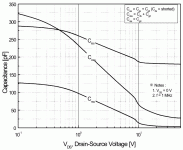Another one has seen the light.
One little red driver board + 2 big Fuji mosfets + two unsuspecting output tubes = big power and low distortion.
The "low distortion" part is the one that surprises me... I expected to see more nastiness, but at least with what I've looked at so far, it's pretty nice!
I'm probably working almost an order of magnitude lower in power than you are, though
The "low distortion" part is the one that surprises me... I expected to see more nastiness, but at least with what I've looked at so far, it's pretty nice!
It shouldn't. If you get that Vds up (attached) internal capacitance isn't a problem. In follower operation, the input capacitance problem goes away as the gate and source are at nearly the same potential, greatly reducing the current through Cgs.
Distortions aren't created equal. The very low output impedance, much lower than for any hollow state device (low single figures for Rd(on) ) goes a long way to get rid of a lot of distortion when taking any VT into Class *2 operation. The 1624 spec sheet gives some impressive THD figures, but with the provision that driver Zo not exceed 500R. That's quite an order for hollow state, but easily attainable with a source follower. Even slapping around screen grids is NBD for a MOSFET. Whatever distortion the MOSFET produces due to parametric frequency multiplication is of much less importance.
I'm probably working almost an order of magnitude lower in power than you are, though
So far, me too, and cathode follower grid drivers have served well. I do have a project in mind that'll hit north of 100W, and for that, a source follower will be part of that design. It's a good idea even if not going for lotsawatts. Part of the problem with disappointing sonics from audio power triodes (especially the 300B) all seem to be related to insufficient grid drive, as these types can pull grid current even if the Vgk isn't actually taken into positive territory. They also have much higher Cmiller, since the plate and grid aren't shielded, and the reverse transfer capacitance is much larger than what you see with pents operating as pents.
Attachments
- Status
- This old topic is closed. If you want to reopen this topic, contact a moderator using the "Report Post" button.
